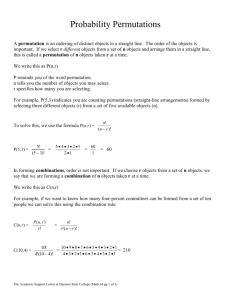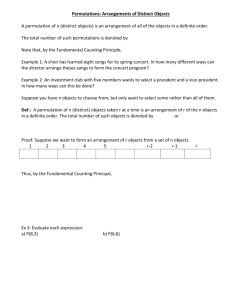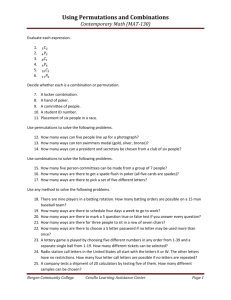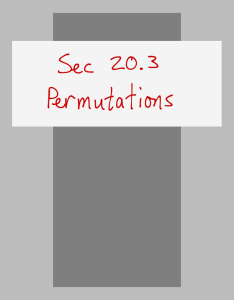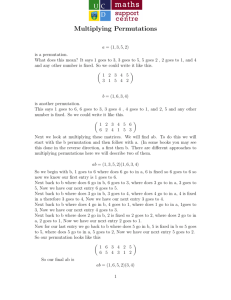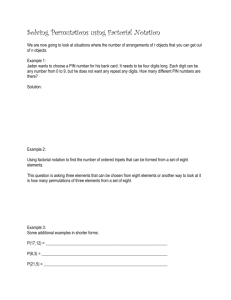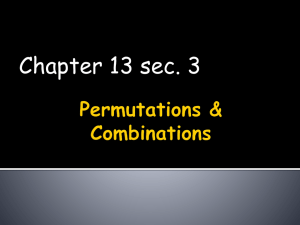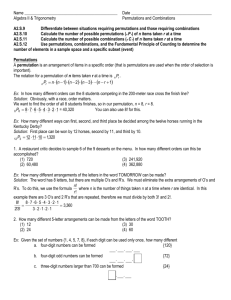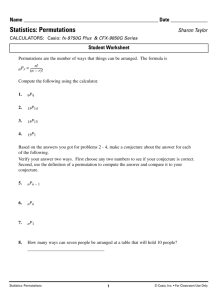Equivalence classes of permutations modulo descents and left
advertisement
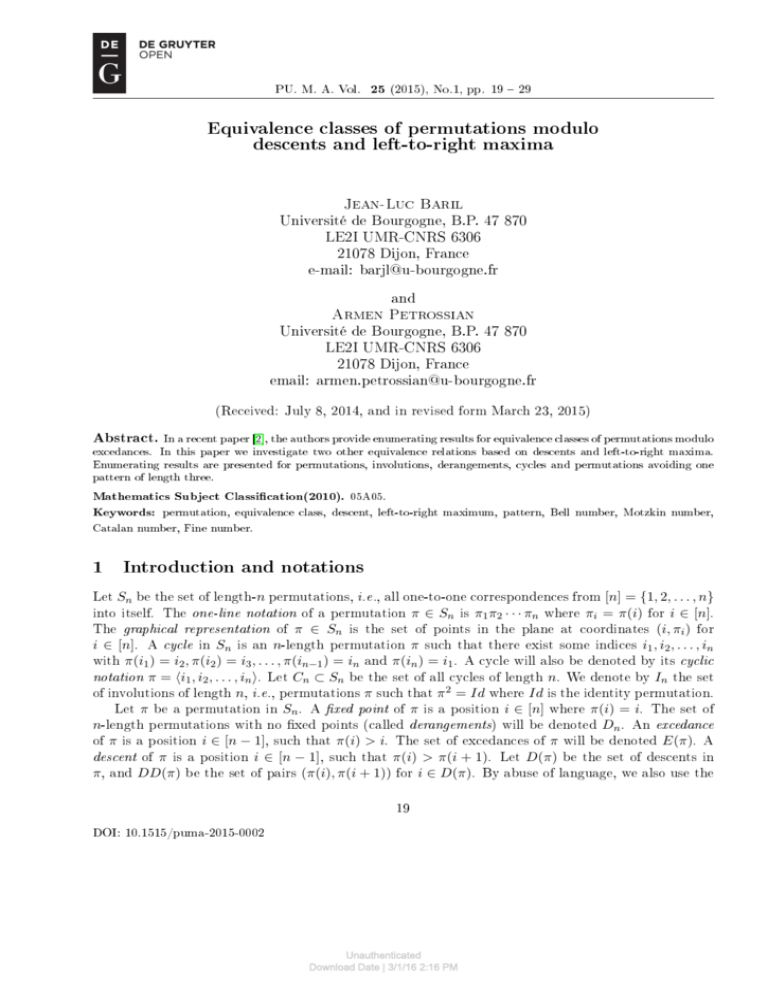
PU. M. A. Vol. 25 (2015), No.1, pp. 19 29
Equivalence classes of permutations modulo
descents and left-to-right maxima
Jean-Luc Baril
Université de Bourgogne, B.P. 47 870
LE2I UMR-CNRS 6306
21078 Dijon, France
e-mail: barjl@u-bourgogne.fr
and
Armen Petrossian
Université de Bourgogne, B.P. 47 870
LE2I UMR-CNRS 6306
21078 Dijon, France
email: armen.petrossian@u-bourgogne.fr
(Received: July 8, 2014, and in revised form March 23, 2015)
Abstract.
excedances.
In a recent paper [2], the authors provide enumerating results for equivalence classes of permutations modulo
In this paper we investigate two other equivalence relations based on descents and left-to-right maxima.
Enumerating results are presented for permutations, involutions, derangements, cycles and permutations avoiding one
pattern of length three.
Mathematics Subject Classication(2010). 05A05.
Keywords: permutation, equivalence class, descent, left-to-right
maximum, pattern, Bell number, Motzkin number,
Catalan number, Fine number.
1
Introduction and notations
Let Sn be the set of length-n permutations, i.e., all one-to-one correspondences from [n] = {1, 2, . . . , n}
into itself. The one-line notation of a permutation π ∈ Sn is π1 π2 · · · πn where πi = π(i) for i ∈ [n].
The graphical representation of π ∈ Sn is the set of points in the plane at coordinates (i, πi ) for
i ∈ [n]. A cycle in Sn is an n-length permutation π such that there exist some indices i1 , i2 , . . . , in
with π(i1 ) = i2 , π(i2 ) = i3 , . . . , π(in−1 ) = in and π(in ) = i1 . A cycle will also be denoted by its cyclic
notation π = hi1 , i2 , . . . , in i. Let Cn ⊂ Sn be the set of all cycles of length n. We denote by In the set
of involutions of length n, i.e., permutations π such that π 2 = Id where Id is the identity permutation.
Let π be a permutation in Sn . A xed point of π is a position i ∈ [n] where π(i) = i. The set of
n-length permutations with no xed points (called derangements) will be denoted Dn . An excedance
of π is a position i ∈ [n − 1], such that π(i) > i. The set of excedances of π will be denoted E(π). A
descent of π is a position i ∈ [n − 1], such that π(i) > π(i + 1). Let D(π) be the set of descents in
π , and DD(π) be the set of pairs (π(i), π(i + 1)) for i ∈ D(π). By abuse of language, we also use the
19
DOI: 10.1515/puma-2015-0002
Unauthenticated
Download Date | 3/1/16 2:16 PM
20
J.-L. BARIL AND A. PETROSSIAN
term descent for such a pair. A left-to-right maximum is a position i ∈ [n], such that π(i) > π(j) for
all j < i. The set of left-to-right maxima of π will be denoted L(π). For instance, if π = 1 4 2 7 5 3 8 6
then E(π) = {2, 4, 7}, D(π) = {2, 4, 5, 7}, DD(π) = {(4, 2), (7, 5), (5, 3), (8, 6)} and L(π) = {1, 2, 4, 7}.
In [2], the authors consider the equivalence relation on Sn in which two permutations π and σ are
equivalent if they coincide on their excedance sets, i.e., E(π) = E(σ) and π(i) = σ(i) for i ∈ E(π).
In this paper we investigate the counterpart of this equivalence relation for descents and left-to-right
maxima. More precisely, we dene the `-equivalence relation ∼` where π ∼` σ if and only if π and σ
coincide on their left-to-right maximum sets, i.e., L(π) = L(σ) and π(i) = σ(i) for i ∈ L(π). Also, we
dene the d-equivalence relation ∼d where two permutations π and σ are equivalent if DD(π) = DD(σ).
The motivation for studying this d-equivalence relation is that two permutations π and σ are equivalent
under excedance ([2]) if and only if φ(π) and φ(σ) are d-equivalent, where φ is the Foata's rst
transformation [5] (see Theorem 6). All these denitions remain available for subsets of Sn . For
instance, the permutation 32541 ∈ S5 is `-equivalent to 32514, 31524, 31542 and d-equivalent to 54132.
The set of `-equivalence (resp. d-equivalence) classes in Sn is denoted Sn∼` (resp. Sn∼d ).
In this paper we propose to compute the number of `- and d-equivalence classes for several subsets
of permutations.
A permutation π ∈ Sn avoids the pattern τ ∈ Sk if and only if there does not exist any sequence
of indices 1 ≤ i1 < i2 < · · · < ik ≤ n such that π(i1 )π(i2 ) . . . π(ik ) is order-isomorphic to τ (see
[13, 14]). We denote by Sn (τ ) the set of permutations of Sn avoiding the pattern τ . For example, if
τ = 123 then 52143 ∈ S5 (τ ) while 21534 ∈
/ S5 (τ ). Many classical sequences in combinatorics appear
as the cardinality of pattern-avoiding permutation classes. A large number of these results were rstly
obtained by West and Knuth [8, 12, 13, 14, 15, 16] (see books of Kitaev [7] and Mansour [11]).
In Section 2, we investigate the equivalence relation based on the set of left-to-right maxima. We
enumerate `-equivalence classes for Sn , Cn , In , Dn and several sets of pattern avoiding permutations.
In Section 3, we study equivalence relation for descents and also provide enumerating results for some
restricted sets of permutations. See Table 1, 2 and 3 for an overview of these results.
2
Enumeration of classes under
`-equivalence
relation
Throughout this section two permutations π and σ belong to a same class whenever they coincide on
their sets of left-to-right maxima, i.e., L(π) = L(σ) and π(i) = σ(i) for i ∈ L(π).
A Dyck path of semilength n, n ≥ 0, will be a lattice path starting at (0, 0), ending at (2n, 0), and
never going below the x-axis, consisting of up steps U = (1, 1) and down steps D = (1, −1). Let Pn be
the set of all Dyck paths of semilength n. A peak of height h ≥ 0 in a Dyck path is a point of ordinate
h which is both at the end of an up step and at the beginning of a down step.
From a permutation π ∈ Sn , we consider the path on the graphical representation of π with up and
right steps along the edges of the squares that goes from the lower-left corner to the upper-right corner
and leaving all the points (i, πi ), i ∈ [n], to the right and remaining always as close to the diagonal
y = x as possible (the path can possibly reach the diagonal but never crosses it). Let us dene the
Dyck path of length 2n (called Dyck path associated with π ) obtained from this lattice path by reading
an up-step U every time the path moves up, and a down-step D every time the path moves to the
right. It is crucial to notice that only the points (i, πi ) with i ∈ L(π) involve in this construction. See
Figure 1 for an illustration of this classical construction.
Unauthenticated
Download Date | 3/1/16 2:16 PM
PERMUTATIONS MODULO DESCENTS AND LEFT-TO-RIGHT MAXIMA
21
8
7
6
5
4
3
2
1
1 2 3 4 5 6 7 8
Figure 1: Permutation σ = 2 5 1 7 3 4 8 6.
Using this construction, all permutations of a same class provide the same Dyck path. Moreover,
any Dyck path in Pn can be obtained from a permutation in Sn . Indeed, we dene the sequence
` = `1 `2 . . . `r , (resp. k = k1 k2 . . . kr ), r ≥ 1 where `i (resp. ki ) is the number (resp. the number
plus one) of up steps U (resp. down steps D) before the i-th peak. Since P is a Dyck path, we have
ki ≤ `i for i ≤ r. So, we dene the permutation π = `1 A1 `2 A2 . . . `r Ar where each `i , i ≤ r, is at
position ki , and such that the concatenated block A1 A2 . . . Ar consists of the increasing sequence of
values in [n]\{`1 , `2 , . . . , `r }. Therefore, `i+1 is greater than all elements in Ai which means that the
set of left-to-right maxima of π is L(π) = {k1 , k2 , . . . , kr } with π(ki ) = `i for i ≤ r. By construction, π
avoids the pattern 321 and P is its associated Dyck path which gives a bijection from Sn∼` to Pn that
induces Theorem 1. In the following, the permutation π will be called the associated permutation of
P . Notice that a similar construction already exists in the literature (see the Krattenthaler bijection
Ψ dened in [9], Section 4).
Theorem
2.1 The sets Sn∼` (resp. Sn (321)∼` ), n ≥ 1, are enumerated by the Catalan numbers (se-
quence A000108 in the on-line Encyclopedia of Integer Sequences [18]).
2.1
Equivalence classes for classical subsets of permutations
In this part we give several enumerating results for classical subsets of Sn (see Table 1).
Theorem
2.2 The sets Dn∼` , n ≥ 1, are enumerated by the Fine numbers (A000108 in [18]).
Using the above construction, we construct a Dyck path P of length 2n from π ∈ Dn . Since
π does not contain any xed point, P does not contain any peak of height one. Conversely, let P be
a Dyck path with no peak of height one and π ∈ Sn (321) be its associated permutation of P (see the
above construction). Since P does not contain any peak of height one, this implies that there does not
exist i ∈ L(π) such that πi = i. Now, for a contradiction, let us assume that there is j ∈
/ L(π) such
that πj = j . Since j ∈
/ L(π), there is i < j such that πi > j = πj . So, there are at most j − 2 values
πk < πj for k < j , or equivalently there is at least one value πk < πj for k > j which contradicts the
fact that π avoids the pattern 321. Finally, the result follows because the set of Dyck paths with no
peak of height one is enumerated by the Fine numbers (see [4]).
2
Proof.
Theorem
sets
Irrn∼` ,
2.3 Let Irrn be the set of permutations π ∈ Sn such that πi 6= πi+1 − 1, 1 ≤ i ≤ n − 1. The
n ≥ 1, are enumerated by the sequence A078481 in [18].
Unauthenticated
Download Date | 3/1/16 2:16 PM
22
J.-L. BARIL AND A. PETROSSIAN
Let π be a permutation in Irrn . Then the Dyck path associated with π does not contain any
consecutive steps of the form U DU D. Conversely, let P be a Dyck path which does not contain any
occurence of consecutive U DU D, and π ∈ Sn (321) be its associated permutation. Since P does not
contain any occurrence of U DU D, this implies that there does not exist i ∈ L(π) such that πi = πi+1 −1.
In the case where there is j , j ∈
/ L(π) such that πj = πj+1 − 1, we dene the blocks of maximal length
J1 , J2 , . . . , Js of the form a, a + 1, . . . , b such that a ≤ b and πa = πa+1 − 1, πa+1 = πa+2 − 1, . . . ,
πb−1 = πb − 1 where a ∈
/ L(π). We consider the permutation σ obtained from π by the following
process: for each block Jk = a, a + 1, . . . , b, 1 ≤ k ≤ s, in the one-line notation of π we replace the
block π(Jk ) with its mirror π(Jk0 ) where Jk0 = b, b − 1, . . . , a. So, σ and π belong to the same class, and
σ ∈ Irrn . For instance, the Dyck path U U U U DDDD would produce π = 4123 ∈
/ Irr4 , then applying
the described process, the permutation σ = 4321 ∈ Irr4 is obtained. Finally, the result is obtained
since the set of Dyck paths with no occurrence of U DU D is enumerated by the sequence A078481 in
[18] (see [17]).
2
Proof.
Theorem
2.4 The sets In∼` , n ≥ 1, are enumerated by the Motzkin numbers (A001006 in [18]).
We will show that each equivalence class contains a unique involution that avoids the pattern
4321 (see A001006 in [18] and [6] for the enumeration of In (4321) by Motzkin numbers). Let π be an
involution in In . If there exists a position i, i < πi , such that i is not a left-to-right maximum, then
there is j ∈ [n] such that j < i < πi < πj which means that π contains the pattern 4321. So, we
dene the involution σ satisfying L(π) = L(σ) and verifying the additional conditions σi = i whenever
i∈
/ L(π). By construction, σ avoids the pattern 4321 and belongs to the same class of π . Conversely,
let σ be an involution avoiding the pattern 4321. Then, the inequality j < i < σi < σj , i, j ∈ [n]
does not occur. Therefore, if i ∈
/ L(σ), then i is necessarily a xed point. Therefore, there is a unique
involution σ ∈ In (4321) having L(σ) as set of left-to-right maxima.
2
Proof.
Theorem
Proof.
2.5 The sets Cn∼` , n ≥ 1, are enumerated by the Catalan numbers (A000108 in [18]).
Any permutation π ∈ Sn−1 can uniquely be decomposed as a product of transpositions
π = hp1 , 1i · hp2 , 2i · · · hpn−1 , n − 1i
where pi are some integers such that 1 ≤ pi ≤ i ≤ n − 1 (see for instance [1]).
Let φ be the map from Sn−1 to Sn dened, for every π ∈ Sn−1 , by
φ(π) = h1, 1i · hp1 , 2i · · · hpn−1 , ni
where π = hp1 , 1i · hp2 , 2i · · · hpn−1 , n − 1i.
Using Corollary 1 in [1], φ is a bijection from Sn−1 to Cn satisfying L(π) = L(φ(π)) for any π ∈ Sn
∼`
and such that φ(π)(k) = π(k) + 1 for k ∈ L(π). Therefore, φ induces a bijection from Sn−1
to Cn∼` .
∼
With Theorem 2.1, the cardinality of Cn ` is the (n − 1)-th Catalan number.
2
2.2
Equivalence classes for
Sn (α)∼`
with
α ∈ S3
In this part we give several enumerating results for the sets Sn (α)∼` where the pattern α lies in S3
(see Table 2).
Unauthenticated
Download Date | 3/1/16 2:16 PM
PERMUTATIONS MODULO DESCENTS AND LEFT-TO-RIGHT MAXIMA
Set
Sequence
Sn∼`
Cn∼`
In∼`
Dn∼`
Irrn∼`
Sloane
Catalan
A000108 1, 2, 5, 14, 42, 132, 429, 1430, 4862
Catalan
A000108
1, 1, 2, 5, 14, 42, 132, 429, 1430
Motzkin
A001006
1, 2, 4, 9, 21, 51, 127, 323, 835
Fine
A000957
0, 1, 2, 6, 18, 57, 186, 622, 2120
Dyck with no UDUD A078481
1, 1, 3, 7, 19, 53, 153, 453, 1367
23
an , 1 ≤ n ≤ 9
Table 1: Number of equivalence classes for classical subsets of permutations.
Theorem 1 proves that Sn (321)∼` is enumerated by the nth Catalan number. Let φ be the bijection
from Sn (321) to Sn (312) described (modulo a basic symmetry) in [3] (Lemma 4.3, page 148). It has
the property to leave all left-to-right maxima xed. Therefore, it induces a bijection from Sn (321)∼`
to Sn (312)∼` .
Now, let us examine the cases where the pattern α belongs to {123, 132, 213, 231}.
Theorem
2.6 The sets Sn (123)∼` , n ≥ 1, are enumerated by the central polygonal numbers 1 + n(n−1)
2
(A000124 in [18]).
Let π be a permutation in Sn (123). It is straightforward to see that the left-to-right maxima of
π are 1 and i where πi = n for some i, 1 ≤ i ≤ n. We necessarily have i − 1 ≤ π1 because the condition
π1 < πj < n implies j < i. Since the values i and j , 1 ≤ i, j ≤ n, characterize a class in Sn (123)∼` , it
n n−1
P
P
follows that the cardinality of Sn (123)∼` is given by 1 +
1 = 1 + n(n−1)
.
2
2
Proof.
i=2 j=i−1
Theorem
2n−1 .
2.7 For α ∈ {132, 213, 231}, the sets Sn (α)∼` , n ≥ 1, are enumerated by the binary numbers
Proof. Let π be a permutation in Sn (231). It can be written π = σnγ where σ ∈ Sk (231) for some
k , 0 ≤ k ≤ n − 1, and γ is obtained from a permutation in Sn−k−1 (231) by adding k on all these
entries. Therefore, the set L(π) of left-to-right maxima of π is the union of {k + 1} with the set L(σ)
of left-to-right maxima of σ . For n ≥ 1, let an be the cardinality of Sn (231)∼` . Varying k from 0 to
n−1
P
n − 1, we have an = 1 +
ak anchored with a1 = 1. Thus, we deduce an = 2n−1 for n ≥ 1.
k=1
Basic symmetries on permutations allow to obtain the result whenever α lies in {132, 312}.
3
Enumeration of classes under
d-equivalence
2
relation
In this section two permutations π and σ belong to a same class whenever DD(π) = DD(σ), i.e., if
the set of pairs (πi , πi+1 ) for i ∈ D(π) is equal to the set of pairs (σi , σi+1 ) for i ∈ D(σ).
A partition Π of [n] is any collection of non-empty pairwise disjoint subsets, called blocks, whose
union is [n]. The standard form of Π is Π = B1 /B2 / . . ., where the blocks Bi are arranged so that
their smallest elements are in increasing order. For convenience, we assume also that elements in a
Unauthenticated
Download Date | 3/1/16 2:16 PM
24
J.-L. BARIL AND A. PETROSSIAN
Pattern
{123}
Sequence
Sloane
Central polygonal A000124
an , 1 ≤ n ≤ 9
1, 2, 4, 7, 11, 16, 22, 29, 37
{312}, {321}
Catalan
A000108 1, 2, 5, 14, 42, 132, 429, 1430, 4862
{132}, {213}, {231}
Binary
A000079
1, 2, 4, 8, 16, 32, 64, 128, 256
Table 2: Number of equivalence classes for permutations avoiding one pattern in S3 .
same block are arranged in decreasing order. From a permutation π ∈ Sn , we associate the unique
partition Π dened as follows. Two elements x > y belong to the same block in Π if and only if there
exist i and j , i < j , such that πi = x > πi+1 > · · · > πj−1 > πj = y . Conversely, any partition
Π = B1 /B2 / . . . /Bk , k ≥ 1, is the associated to the permutation B1 B2 . . . Bk . Theorem 8 becomes a
straightforward consequence.
Theorem
3.1 The sets Sn∼d , n ≥ 1, are enumerated by the Bell numbers (A000110 in [18]).
Theorem
3.2 The sets Sn (321)∼d , n ≥ 1, are enumerated by the Motzkin numbers (A001006 in [18]).
Let π ∈ Sn (321) and DD(π) = {(M1 , m1 ), (M2 , m2 ), . . . , (Mr , mr )}, r ≥ 0, be the set of pairs
(πi , πi+1 ) where i is a descent of π . Since π avoids 321, DD(π) does not contain two pairs of the form
(πi , πi+1 ) and (πi+1 , πi+2 ). Then, we dene the involution σ ∈ In as follows: σ(Mi ) = mi , σ(mi ) = Mi
for 1 ≤ i ≤ r and σ(k) = k if k does not appear in any pair of DD(π). For a contradiction, let us
assume that σ contains a pattern 4321. Then there exist two pairs (Mi , mi ) and (Mj , mj ) in DD(π)
such that Mi > Mj > mj > mi . If the descent (Mi , mi ) is on the left (in π ) of the descent (Mj , mj ),
then the subsequence Mi Mj mj is a pattern 321 of π ; otherwise, the subsequence Mj mj mi also is a
321-pattern. In the two cases we obtain a contradiction, which ensures that the involution σ avoids
the pattern 4321.
Conversely, let σ be an involution avoiding the pattern 4321. There exists a sequence of pairs
(M1 , m1 ), . . . , (Mr , mr ), r ≥ 0, such that Mi < Mi+1 , mi < mi+1 for i ≤ r − 1 and such that Mi > mi ,
σ(Mi ) = mi and σ(mi ) = Mi for i ≤ r and σ(k) = k for k ∈ [n]\{M1 , . . . , Mr , m1 , . . . , mr }. We dene
the permutation π with the following process. We start with the sequence M1 m1 M2 m2 . . . Mr mr ; we
insert in increasing order all other values k satisfying σ(k) = k as follows: if mi−1 < k < mi then we
insert k between mi−1 and Mi ; if k < m1 then we insert k before M1 ; and if k ≥ mr then we insert k
after mr . Obviously, this construction induces that π avoids 321. Moreover, σ can be obtained from π
by the construction of the beginning of this proof. Thus, there is a bijection between Sn (321)∼d and
In (4321) which is enumerated by the Motzkin numbers (see A001006 in [18] and [6]).
2
Proof.
3.3 Let π and π 0 be two permutations in Sn (132) belonging to the same d-equivalence class. If
we have π1 = π10 then π = π 0 .
Lemma
We proceed by induction on n. A simple observation gives the result for n ≤ 3. Now, let us
assume that Lemma 1 is true for k ≤ n − 1. Let π and π 0 be two permutations in Sn (132) such that
π1 = π10 . We can write π = αnβ (resp. π 0 = α0 nβ 0 ) where β ∈ Sk (132) for some k , 0 ≤ k ≤ n − 1
(resp. β 0 ∈ Sk0 (132) for some k 0 , 0 ≤ k 0 ≤ n − 1), and α (resp. α0 ) is obtained from a permutation in
Proof.
Unauthenticated
Download Date | 3/1/16 2:16 PM
25
PERMUTATIONS MODULO DESCENTS AND LEFT-TO-RIGHT MAXIMA
Sn−k−1 (132) (resp. Sn−k0 −1 (132)) by adding k (resp. k 0 ) on all these entries. Let m (resp. m0 ) be the
minimal value of α (resp. α0 ).
Without loss of generality, we assume that m0 ≤ m ≤ π1 = π10 . For a contradiction, assume that
0
m < m. So, there is two consecutive entries a and m0 in α0 such that a > m0 . As m0 < m, the
descent (a, m0 ) does not appear in α. Thus, (a, m0 ) appears in β . Let α1 be the rst value of α; the
subsequence α1 am0 is necessarily a pattern 132 which is a contradiction. Thus, we have m = m0 and
then k = k 0 . We deduce α and α0 (resp. β and β 0 ) are d-equivalent and the recurrence hypothesis
gives α = α0 . Moreover the descent (n, β1 ) is equal to the descent (n, β10 ) and then β1 = β10 . Using the
recurrence hypothesis we conclude β = β 0 and then, π = π 0 .
2
Theorem
3.4 The sets Sn (132)∼d , n ≥ 1, are enumerated by cn − cn−1 + 1 where cn =
n-th Catalan number.
2n
1
n+1 n
is the
Let an be the cardinality of Sn (132)∼d . We distinguish three kinds of classes: (1) classes with
a representative π satisfying π1 = n; (2) classes with a representative π satisfying πn = n; (3) the
remaining classes.
Case (1). Such a class contains a permutation π such that π1 = n, i.e., π = nπ 0 with π 0 ∈ Sn−1 (132).
Using Lemma 3.3, there is a unique σ = π 0 ∈ Sn−1 (132) such that nσ and π belong to the same class.
Thus, the number of classes in this case is also the cardinality of Sn−1 (132), that is the (n − 1)-th
Catalan number cn−1 .
Case (2). Such a class contains a permutation π such that πn = n. So, the number of classes in this
case is also the number of elements in Sn−1 (132)∼d , that is an−1 .
Case (3). Now we consider the classes that do not lie in the two previous cases. Any permutation π of
such a class satises πi = n for some i ∈ [2, n − 1], and since π avoids 132, π can be written π = αnβ
where β ∈ Sn−i (132) and α is obtained by adding (n − i) on all entries of a permutation in Si−1 (132).
Let us consider j , 1 ≤ j ≤ i − 1, the position where α reaches its minimum m.
If j = 1 then π = (n − i + 1) . . . (n − 1)nβ and this permutation lies in the same class of nβ(n −
i + 1) . . . (n − 1) that satises Case (1). Then, j = 1 does not occur.
Now we assume j ≥ 2 and let σ be a permutation in Sn (132) lying in the same class of π . Then, σ
must contain the two descents (n, πi+1 ) and (πj−1 , m). These two descents necessarily appear in the
same order as in π (otherwise, a pattern 132 would be created with πi+1 πj−1 m). Thus, the minimum
m0 of values on the left of n in σ is necessarily less or equal to m. For a contradiction, let us assume
that m0 < m. The value m0 appears necessarily on the right of the descent (πj−1 , m) in σ (otherwise,
m0 πj−1 m would be a pattern 132). Therefore, a descent of the form (a, b), a ≥ m and b < m would
necessarily exists in σ , which is not possible because such a descent cannot belong in π .
Thus, we deduce m = m0 and σ has the similar decomposition σ = α0 nβ 0 where β 0 ∈ Sn−i (132)
and α0 is obtained by adding (n − i) on all entries of some permutation in Si−1 (132). So, α (resp. β )
is equivalent to α0 (resp. β 0 ). Hence, Lemma 3.3 implies that β = β 0 . Then, for a given i ∈ [2, n − 1],
there are exactly cn−i · (ai−1 − 1) classes verifying this case (we subtract one to ai−1 because we do
not consider π = (n − i + 1) . . . nβ ).
n−1
P
So, such classes are enumerated by
(ak−1 − 1) · cn−k .
Proof.
k=2
Unauthenticated
Download Date | 3/1/16 2:16 PM
26
J.-L. BARIL AND A. PETROSSIAN
Considering the three cases, the cardinality an of Sn (132)∼d satises for n ≥ 2,
an = cn−1 + an−1 +
n−1
X
(ak−1 − 1) · cn−k .
k=2
A simple calculation proves that an = cn − cn−1 + 1 for n ≥ 2.
2
3.5 The sets Sn (123)∼d , n ≥ 2, are enumerated by cn + n − (n + 2) · 2n−3 + (n−2)(n−1)
where
2
2n
n is the n-th Catalan number.
Theorem
cn =
1
n+1
Proof. Let π be a permutation in Sn (123). Then π has a unique decomposition into blocks of decreasing
sequences, i.e., π = A1 A2 . . . Ar , 1 ≤ i ≤ r, where blocks Ai consist of sequences of decreasing values
(possibly reduced to one value) and such that `i < fi+1 for 1 ≤ i ≤ r − 1, where fi (resp. `i ) is the
rst (resp. last) element of Ai .
We distinguish three cases (1) r = 1; (2) r = 2; and (3) r ≥ 3.
Case (1). We necessarily have π = n(n − 1) . . . 21 and its equivalence class contains only one element.
Case (2). We have π = A1 A2 with `1 < f2 . (i) If f1 < `2 then the class of π contains only one
element since the permutation σ = A2 A1 is not there. Therefore, there are (n − 1) such classes. (ii)
If f1 > `2 then the class of π contains exactly two elements π and σ = A2 A1 . Since the number of
permutations of length n with n − 2 descents is 2n − (n + 1), the number of classes for the subcase (ii)
n
is 2 −(n+1)−(n−1)
= 2n−1 − n. Finally, there are 2n−1 − n + n − 1 = 2n−1 − 1 classes for Case (2).
2
Case (3). π contains at least three blocks. We decompose π = A1 BAr where B = A2 . . . Ar−1 , r ≥ 3,
such that f2 = n, `r−1 = 1 with A1 and Ar possibly empty.
Let σ be a permutation in Sn (123) belonging to the class of π . We will prove that σ is either π or
Ar BA1 .
For this, we will prove that the block B also appears in σ . It is obvious whenever B is a decreasing
sequence. Now, let us assume that B is the concatenation of at least two blocks, that is B = A2 . . . Ar−1
with r ≥ 4.
(i) For a contradiction, we suppose that there exist i and j , 2 ≤ i < j ≤ r − 1 such that Ai appears
on the right of Aj into σ , i.e., σ = αAj βAi γ for some α, β, γ possibly empty. Since σ avoids 123 and
fj < fi , α does not contain any value a such that a < fj (otherwise afj fi would be a pattern 123).
Also, α does not contain any value a such that a > fj (otherwise there would be b ≤ a such that (b, fj )
is descent in σ that does not appear in π ). Thus α is necessarily empty. By a simple symmetry , γ
is also empty. This implies that all other blocks of π appear between the two blocks Aj and Ai in σ .
Thus, all other blocks consist of values a such that a ∈ [1, `j − 1] ∪ [fi + 1, n] (otherwise `j afi would
be a pattern 123). Since π contains at least three blocks there is at least one block between Aj and Ai
in σ .
The case `j = 1 does not occur. Indeed, this would mean that all blocks between Aj and Ai contain
values x greater than fi which creates a descent of the form (x, fi ) that does not appear in π . A similar
argument proves that fi = n does not occur.
Let us consider the case where n and 1 do not appear in Ai and Aj . Since B contains at least two
blocks, n and 1 do not appear in the same block in B . Let R (resp. S ) be the block containing n (resp.
1). In σ , the last element `(R) of R is necessarily less than `j (otherwise σ would contain a pattern
123, that is `j `(R)x where x is the value just after `(R) in σ ). A same argument shows that the rst
Unauthenticated
Download Date | 3/1/16 2:16 PM
PERMUTATIONS MODULO DESCENTS AND LEFT-TO-RIGHT MAXIMA
27
element f (S) of S is greater than fi . In π , this would mean that `(R)`i f (S) is a pattern 123 which is
a contradiction. Finally, all blocks of B appear in σ in the same order as π .
(ii) Now we will prove that A1 does not appear between A2 and Ar−1 in σ . For a contradiction,
let us assume that A1 appears between A2 and Ar−1 in σ . Let a be the value of σ just after the block
A1 . If a < `1 then σ contains the descent (`1 , a) that does not appear in π ; otherwise, `2 `1 a would
be a pattern 123 in σ which gives a contradiction. A same argument proves that Ar does not appear
between A2 and Ar−1 in σ .
Therefore, we deduce that either σ = π or σ = Ar BA1 .
Now we will enumerate permutations π ∈ Sn (123) of Case (3) such that there is σ ∈ Sn (123),
σ 6= π , belonging to the same class of π , i.e., A1 BAr and Ar BA1 do not contain any pattern 123. This
case is characterized by the fact that there is no value a in the block B such that min {`1 , `r } < a <
max {f1 , fr } (otherwise, one of the two permutations A1 BAr , Ar BA1 would contain the pattern 123).
See Figure 1 for a graphical representation of such a permutation.
Figure 2: Illustration of π = A1 BAr ∈ Sn (123) having two elements in its class.
If B contains only one block, A1 and Ar are non-empty blocks. Varying the size k of B from 2 to
n − 2, and the size ` of A1 from 1 to n − k − 1, the number of permutations having two elements in its
n−k−1
n−2
P n−k
P
(k − 1) ·
class is an =
` .
k=2
`=1
If B contains at least two blocks, A1 and Ar are blocks (possibly empty). Varying the size k of B
from 4 to n − 1 and varying the size ` of A1 from 0 to n − k , the number of permutations having two
n−1
n−k
P k−2
P n−k
elements in its class is bn =
(2
− (k − 1)) ·
` .
k=4
`=0
Finally, the number of classes in Sn (123) is obtained from cn by subtracting the number of classes
having two elements, that is cn − 21 (2n − 2n + an + bn ) = cn − (n + 2) · 2n−3 + n(n−1)
+ 1.
2
2
References
[1]
J.-L. Baril,
Statistics-preserving bijections between classical and cyclic permutations, Inform.
Process. Lett., 113 (2003) 1722.
[2]
J.-L. Baril, T. Mansour and A. Petrossian,
excedances, J. Comb., 5 (2014) 453469.
Equivalence classes of permutations modulo
Unauthenticated
Download Date | 3/1/16 2:16 PM
28
J.-L. BARIL AND A. PETROSSIAN
Pattern
Sequence
{}
Bell
{231}, {312}
Catalan
A000108
1, 2, 5, 14, 42, 132, 429, 1430, 4862
{321}
Motzkin
A001006
1, 2, 4, 9, 21, 51, 127, 323, 835
{132}, {213}
cn − cn−1 + 1
New
1, 2, 4, 10, 29, 91, 298, 1002, 3433
{123}
2n−3
New
1, 2, 4, 9, 25, 84, 307, 1139, 4195
cn − (n + 2) ·
Sloane
an , 1 ≤ n ≤ 9
A000110 1, 2, 5, 15, 52, 203, 877, 4140, 21147
+
n(n−1)
2
+1
Table 3: Number of equivalence classes for permutations avoiding at most one pattern of S3 .
[3]
[4]
M. Bona,
Combinatorics of permutations, Chapman and Hall/CRC, Second Edition, 2012.
E. Deutsch and L. Shapiro,
241265.
A survey of the Fine numbers, Discrete Math., 241 (2001)
[5]
D. C. Foata and M. P. Schützenberger,
Théorie Géométrique des Polynômes Euleriens,
[6]
O. Guibert, E. Pergola and R. Pinzani,
Vexillary involutions are enumerated by Motzkin
[7]
S. Kitaev,
[8]
D. E. Knuth,
[9]
Lecture Notes in Math., 138, Springer-Verlag, Berlin, 1970.
numbers, Ann. Comb., 5 (2001) 153174.
Patterns in permutations and words, Springer-Verlag, 2011.
The art of computer programming, Volume I, Addison-Wesley, Reading MA,
Third edition, 1997.
C. Krattenthaler,
Permutations with restricted patterns and Dyck paths, Adv. in Appl.
Math., 27 (2001) 510530.
Combinatorics of Set Partitions, Discrete Mathematics and its Applications,
[10]
T. Mansour,
[11]
T. Mansour,
Permutations avoiding a pattern from Sk and at least two patterns from S3 , Ars.
Combin., 62 (2002) 227239.
[12]
Chapman & Hall/CRC, 2013.
T. Mansour and A. Vainshtein,
26 (2001) 258269.
Restricted 132-avoiding permutations, Adv. Appl. Math.,
Restricted permutations, European J. Combin., 6 (1985)
[13]
R. Simion and F.W. Schmidt,
[14]
J. West,
Permutations with forbidden subsequences and stack-sortable permutations, Ph.D.
[15]
J. West,
Generating trees and forbidden subsequences, Local Proceedings of FPSAC 1994,
383406.
Thesis, MIT, 1990.
441450.
Unauthenticated
Download Date | 3/1/16 2:16 PM
PERMUTATIONS MODULO DESCENTS AND LEFT-TO-RIGHT MAXIMA
29
Generating trees and the Catalan and Schröder numbers, Discrete Math., 146
[16]
J. West,
[17]
A. Sapounakis, I. Tasoulas and P. Tsikouras,
[18]
N.J.A. Sloane,
On-Line Encyclopedia of Integer Sequences, http://oeis.org/.
[19]
R. P. Stanley,
Enumerative Combinatorics, Volume I, Cambridge University Press, 2002.
(1995) 247262.
Math., 307 (2007) 29092924.
Unauthenticated
Download Date | 3/1/16 2:16 PM
Counting strings in Dyck paths, Discrete
